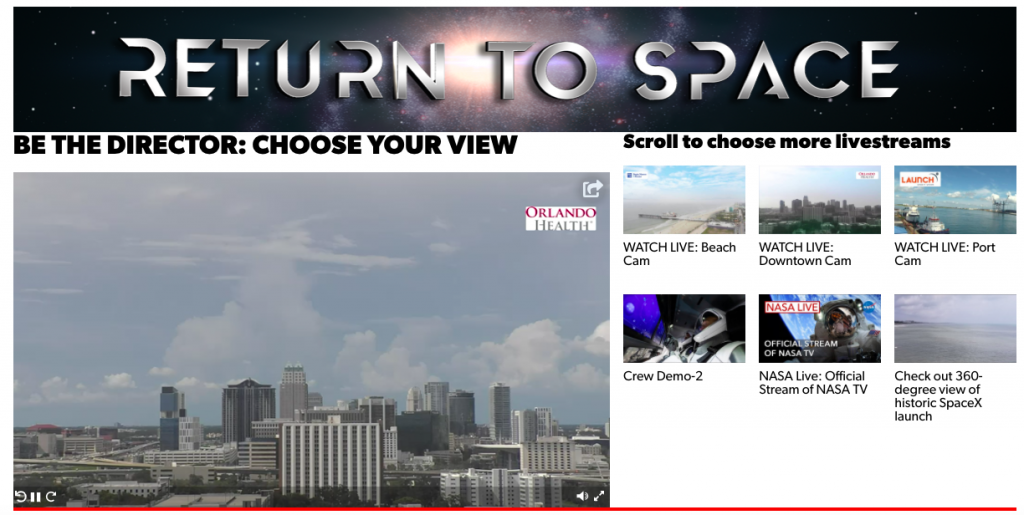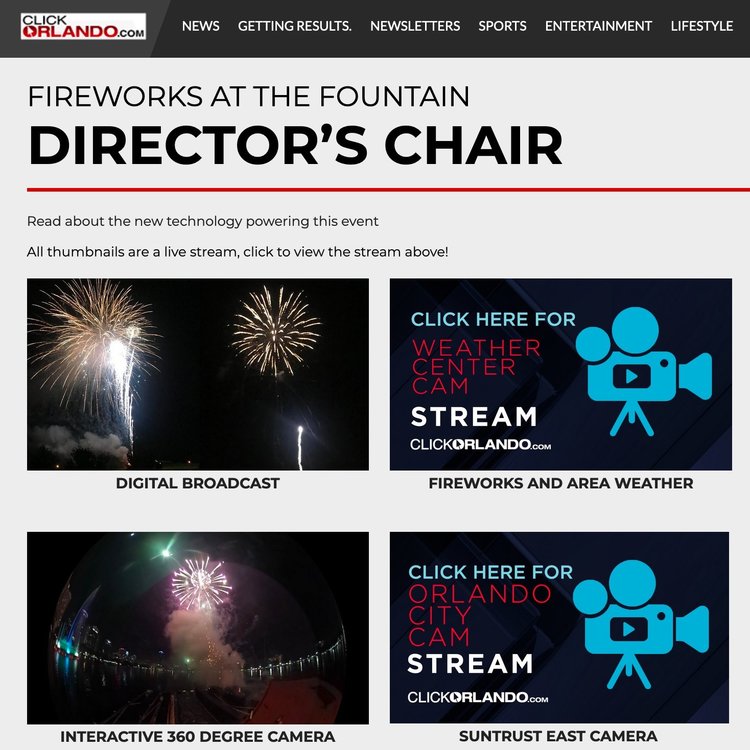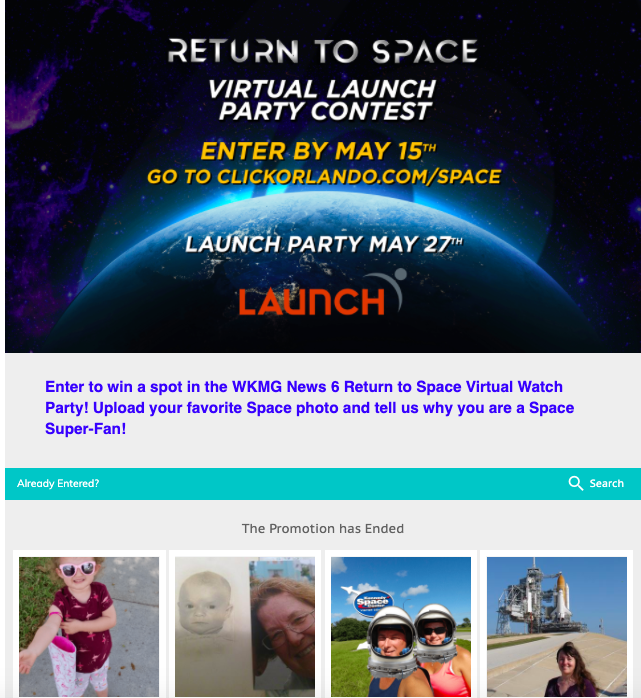
What if you let your audience members direct the newscast? Or step in as the talent?
For the much-anticipated NASA and SpaceX launch back in May, Graham Media Group’s Orlando station WKMG-TV turned its website into an interactive livestream hub, part of a dramatic technology initiative that is changing the way its stations think about video.
“I’m not a huge fan as a news director of doing things whiz-bang for the sake of whiz-bang. I think it’s got to be for the benefit of the user and for the viewer experience,” said WKMG News Director Allison McGinley.
But amid a global pandemic, McGinley felt her station had no choice but to get creative with its coverage of the historic space launch in a market where many viewers would normally watch it in person.
“We knew we had history unfolding in our backyard, — what do we do to make this special? If I want to say that there is a silver lining to COVID-19, it’s the fact that we as a television station have to innovate how we bring experiences to people, “ said McGinley. “Even NASA was saying stay home, watch it on television, watch it online. We don’t want to send our viewers to nasa.gov. We want to create an experience on ClickOrlando.com and for WKMG viewers.”
While WKMG still aired customary special event coverage on TV, app, and OTT platforms, the innovation centered around a special Return to Space page on the station’s website, ClickOrlando.com.
Just as a technical director in the control room chooses when to cut to camera two, visitors to WKMG’s ClickOrlando.com could choose their own view of the SpaceX coverage. Want to watch it from a 360-degree perspective of the beach? What about from the back of the newsroom? How about from the inside of the SpaceX cockpit next to the NASA astronauts? Viewers could choose which livestream cameras they wanted to watch and when — leading all the way up to the second try of the launch at 3:22 pm on May 30.
Watch a WKMG reporter explain how audience members can choose their view of the SpaceX launch
Visitors could experience history right from their living room by choosing from one of up to 20 views, including a 360-degree camera streaming for the launch.
WKMG first tried out this ‘Be The Director’ technology back in 2019, producing over 100 hours of livestream content for the station’s annual coverage of July 4th fireworks. By partnering with Arc Publishing, Graham found a solution to the challenge of offering multiple livestreams. This event served as a test for the Broadcast mobile app, an innovation supported by a Google News Initiative grant that allows journalists to stream high-quality live video anywhere from their phones.

Before switching to Arc and launching the new Broadcast app, Graham had relied on Facebook Live for streaming. Now Graham stations have more control over content, digital properties and ad revenue. Since the transition to Arc’s platform in March of 2019, Graham Media Network says it has seen a 185% increase in daily users on its website.
That new technology paved the way for this year’s SpaceX coverage by WKMG. Visitors to the Return to Space page could choose from among 20 different livestreams, including feeds from a dozen reporters using their smartphones and the Broadcast app. Reporters at various locations along Space Coast would come in live on the page whenever they had something to share or someone to interview.
Jonathan Beard, the Graham Media Group Director of Digital Product Development, values working with the forward-thinking Orlando station. “Being so digitally focused, they don’t even think of it as digital,” said Beard. “They just think, how can I take my coverage to the next level?

Just like the fireworks, a space launch is a planned event, allowing time for the station to get its people and technology in line. Still, despite the “whiz-bang” factor, McGinley felt something was missing from the launch coverage plan. “With that messaging of stay home, watch it from home, the thought process was how do we still encourage our viewers to interact? Because this is a human experience. This [SpaceX Launch] is history. This isn’t something you want to experience by yourself,” said McGinley.
So WKMG created a contest where 12 chosen space fans became “talent” in a virtual Zoom watch party for the launch.

The 12 winners joined WKMG’s own super space fans — anchor Ginger Gadsden and meteorologist Jonathan Kegges. They spent close to six hours together on three different Zoom calls: a technical dry run, the scrubbed launch day, and again on the successful take-off day.
“The Zoom participants had a fantastic time. They didn’t really want it to end. They played games, they did trivia, they shared a story with each other, ” said Allison. “We got emails from some of those folks. One I’m thinking about now said we covered things better than the Discovery Channel.”
Clip from the Zoom watch party
The rest of the WKMG audience could still join in on the action. The “Return To Space Virtual Launch Party” on Zoom was also available as one of the 20 featured views on the ClickOrlando.com site.
“The whole experience was streamed live for the rest of the audience to kind of look over the shoulder and watch this watch party in real-time. It’s kind of like what you do with a Twitch stream where you’re watching people participate in a game,” said Beard. “ So it was a bit of a window within a window within a window kind of experience. But it turned out to be fantastic.”
The SpaceX Watch Party received 50 times more views than an average broadcast livestream by the station.
“I think what everybody really needs to be thinking about is not where I am covering the story, but how does the viewer need me to cover this story?” said McGinley. “And have fun, on stuff like this. Obviously not on the harder breaking news or the deadly storms and things like that. But I mean, for goodness sakes, you got a rocket launch. Let’s have some fun.”
WKMG has begun incorporating immersive audience-driven technology routinely in its hurricane coverage, as well as in 360-degree newscasts where the audience can move virtually through the studio. “It [livestream technology] has become the transformative thing that we had hoped it would be. So it doesn’t just have to be a specific event that’s planned. They’re using these things, at a less intensive scale, but day in and day out,” said Beard.
WKMG 360 degree Newscast
McGinley says the aggressive use of immersive and interactive technology is propelling her station into the future.
“I think [the livestream technology] reinvigorated the newsroom, because they all want to find a way that they can take part in a big event in a potentially different way,” said McGinley. “I definitely have a younger group of producers and digital producers in my newsroom who are so hungry to create this hybrid world.”